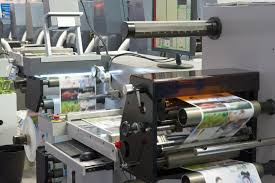Offset printing is a technique usually used for printing jobs that are produced in large quantities, such as books, magazines, brochures, catalogs. In this method, ink is transferred onto a metal plate, which is then printed onto paper. It is the preferred method to ensure high quality and cost-effective results.
Contents:
What is Offset Printing?
Offset printing is a printing technology widely used in the production of materials such as books, magazines, brochures, catalogs to be printed in large quantities. This technique is an ideal option for achieving high-quality and cost-effective results.
The process is carried out using a sheet of metal. First, the designed image or text is transferred to this metal sheet through computer-aided software. The sheet is then coated with ink, but this ink is not transferred directly to the paper, but through a roller. The inked roller is then passed over paper or other printing materials to print. This method offers a highly effective way to achieve smooth and high quality prints.
The advantages of offset printing include high resolution, wide color gamut, sharp details, long-lasting prints and fast production processes. It is also cost-effective when printing in large quantities, which is one of the reasons why it is preferred. It is generally preferred to meet professional printing needs and is used on an industrial scale.
What are the Types of Offset Printing?
Single Color Offset Printing: In this method, only one color is used. It is generally preferred for applications such as simple texts or logos.
Four Color Offset Printing (CMYK): CMYK is known as a printing process consisting of cyan, magenta, yellow and black colors. With this method, a wide color gamut is obtained and high quality printing of color images such as photographs can be achieved.
Special Color Offset Printing: It is a type in which special colors such as special Pantone colors are used. It ensures that certain colors are printed accurately and consistently.
Lacquered Offset Printing: Afterwards, a glossy or matte protective coating is applied on the material, creating a visual and tactile difference.
Foil and Embossing on Offset Printing: Aesthetic and tactile richness is added to the printing material by applying a special foil or embossing process afterwards.
Varnish on Offset Printing: Matte or glossy varnish can be applied after printing. This can contribute to the protection and visual appeal of the print.
Each type of print is used for different purposes and is selected according to the characteristics of its material. To achieve a professional result, it is important to choose the right type of print.

What is Offset Paper?
Offset paper is a type of printing paper designed and optimized specifically for offset printing. This type of paper is specially produced and used to provide the best performance for printing methods. Here are the features and advantages of offset papers:
Surface Smoothness: Offset papers generally have a flat and smooth surface. This feature ensures that the ink is transferred smoothly to the paper during printing and helps to achieve clear, sharp printing results.
Absorbency Feature: Offset papers have features that absorb ink quickly and prevent it from spreading on the paper. This allows prints to dry faster and reduces the risk of ink smudges.
Thickness and Durability: Offset papers are generally available in medium to high weights. This increases the strength of the paper and ensures durability in post-printing uses.
Color Reflection: Offset papers are designed to ensure that colors are accurately and vividly reflected. They have color reflection properties especially suitable for CMYK printing.
Affordable Cost: Offset papers are a cost-effective option for jobs that typically require printing in large quantities. High-quality print results and a long service life are among the reasons why they are preferred.
Offset papers are an ideal option for many commercial materials such as books, magazines, brochures, catalogs and more. These specially produced papers play an important role in improving quality and performance in printing processes.
Conclusion:
As a result, offset printing is an ideal option to meet the needs for high quality and large quantities of printing. A technologically advanced process, offset printing is a common printing technology used in the production of various materials.
